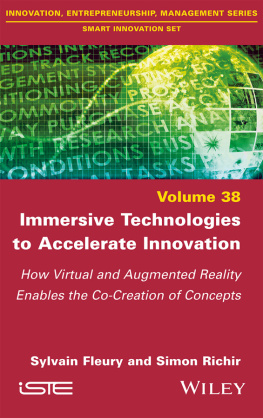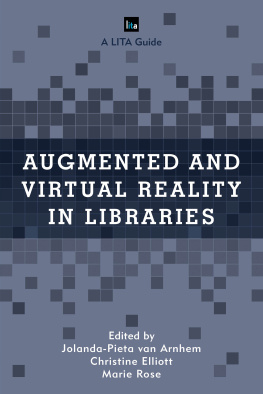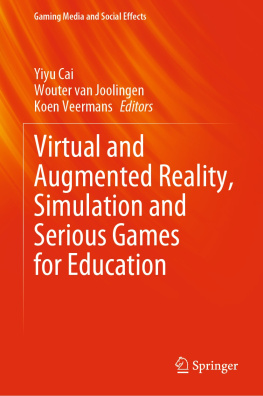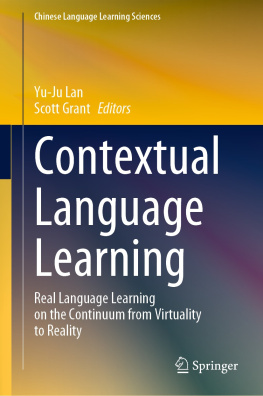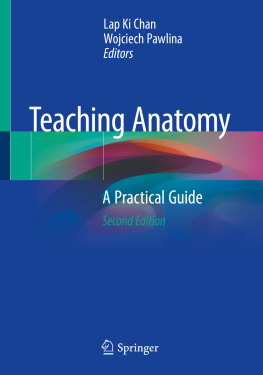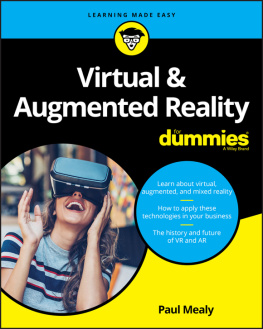HumanComputer Interaction Series
Editors-in-Chief
Desney Tan
Microsoft Research, Redmond, WA, USA
Jean Vanderdonckt
Louvain School of Management, Universit catholique de Louvain, Louvain-La-Neuve, Belgium
The HumanComputer Interaction Series, launched in 2004, publishes books that advance the science and technology of developing systems which are effective and satisfying for people in a wide variety of contexts. Titles focus on theoretical perspectives (such as formal approaches drawn from a variety of behavioural sciences), practical approaches (such as techniques for effectively integrating user needs in system development), and social issues (such as the determinants of utility, usability and acceptability).
HCI is a multidisciplinary field and focuses on the human aspects in the development of computer technology. As technology becomes increasingly more pervasive the need to take a human-centred approach in the design and development of computer-based systems becomes ever more important.
Titles published within the HumanComputer Interaction Series are included in Thomson Reuters' Book Citation Index, The DBLP Computer Science Bibliography and The HCI Bibliography.
More FREE books, at: www.textseed.xyz
Editors
Jean-Franois Uhl , Joaquim Jorge , Daniel Simes Lopes and Pedro F. Campos
Digital Anatomy
Applications of Virtual, Mixed and Augmented Reality
1st ed. 2021

Logo of the publisher
Editors
Jean-Franois Uhl
Paris Descartes University, Paris, France
Joaquim Jorge
INESC-ID Lisboa, Instituto Superior Tcnico, Universidade de Lisboa, Lisbon, Portugal
Daniel Simes Lopes
INESC-ID Lisboa, Instituto Superior Tcnico, Universidade de Lisboa, Lisbon, Portugal
Pedro F. Campos
Department of Informatics, University of Madeira, Funchal, Portugal
ISSN 1571-5035 e-ISSN 2524-4477
HumanComputer Interaction Series
ISBN 978-3-030-61904-6 e-ISBN 978-3-030-61905-3
https://doi.org/10.1007/978-3-030-61905-3
The Editor(s) (if applicable) and The Author(s), under exclusive license to Springer Nature Switzerland AG 2021
This work is subject to copyright. All rights are solely and exclusively licensed by the Publisher, whether the whole or part of the material is concerned, specifically the rights of translation, reprinting, reuse of illustrations, recitation, broadcasting, reproduction on microfilms or in any other physical way, and transmission or information storage and retrieval, electronic adaptation, computer software, or by similar or dissimilar methodology now known or hereafter developed.
The use of general descriptive names, registered names, trademarks, service marks, etc. in this publication does not imply, even in the absence of a specific statement, that such names are exempt from the relevant protective laws and regulations and therefore free for general use.
The publisher, the authors and the editors are safe to assume that the advice and information in this book are believed to be true and accurate at the date of publication. Neither the publisher nor the authors or the editors give a warranty, expressed or implied, with respect to the material contained herein or for any errors or omissions that may have been made. The publisher remains neutral with regard to jurisdictional claims in published maps and institutional affiliations.
This Springer imprint is published by the registered company Springer Nature Switzerland AG
The registered company address is: Gewerbestrasse 11, 6330 Cham, Switzerland
Foreword by Mark Billinghurst
As a discipline, anatomy can trace its roots back to at least ancient Egypt and papyri that described the heart and other internal organs. In the thousands of years since knowledge of anatomy improved dramatically, in most of that history the main way to understand the body was through dissection and looking beneath the skin. At the close of the nineteenth century, the development of the X-ray machine enabled images to be captured from within the body, and this was followed by many other imaging technologies. At the same time at the invention of the CT scanner, the first interactive computer graphics was also demonstrated. Since then advances in computer graphics and medical imaging have gone hand in hand. Digital anatomy has emerged as an essential subfield of anatomy that processes the human body in a computer-accessible format.
The many different revolutions brought about by computer graphics, visualization, and interactive techniques have meant that digital anatomy is a rapidly evolving discipline. One of the main goals is to provide a greater understanding of the spatial structure of the body and its internal organs. Virtual Reality (VR) and Augmented Reality (AR) are particularly valuable for this. Using VR, people can immerse themselves in a graphical representation of the body, while with AR virtual anatomy can be superimposed back into the real body. Both provide an intuitive way to view and interact with digital anatomy, which could bring about a revolution in many health-related fields. This book provides a valuable overview of applications of Virtual, Mixed, and Augmented Reality in Digital Anatomy.
Just as X-ray machines and CT scanners changed twentieth-century healthcare, medical image analysis is revolutionizing twenty-first-century medicine, ushering in powerful new tools designed to assist the clinical diagnosis and to better model, simulate, and guide the patients therapy more efficiently. Doctors can perform image-guided surgery through small incisions in the body and use AR and VR tools to help with pre-operative planning. In academic settings, digital technologies are changing anatomy education by improving retention and learning outcomes with new learning tools such as virtual dissection. This book provides comprehensive coverage of many medical applications relying on digital anatomy ranging from educational to pathology to surgical uses.
An outstanding example of the value of digital anatomy was the Visible Human Project (VHP) unveiled by the United States National Library of Medicine at the end of the twentieth century. The VHP made high-resolution digital images of anatomical parts of a cryosectioned body freely available on the Internet, accompanied by a collection of volumetric medical images acquired before slicing. These images are used by computer scientists worldwide to create representations of most organs with exceptional precision. Many other projects, including the Visible Korean and Chinese visible human male and female projects, achieved greater fidelity of images and improved anatomical details. Digital atlases based on the VHP have made it possible to navigate the human body in three dimensions, and have proven to be immensely valuable as an educational tool.
These original virtual human reconstructions were very labor-intensive and only depicted a single persons particular structures. There remains much arduous work to be done to make the data derived from visible human projects meet the application-oriented needs of many fields. Researchers are making significant progress toward developing new datasets, segmenting and creating computer-assisted medicine platforms. In the second decade of the twenty-first century, a new approach is used: we no longer seek to visualize individual representations of anatomy but rather model and display statistical representations within an entire population. Modern approaches use powerful algorithmic and mathematical tools applied to massive image databases to identify and register anatomical singularities to visualize statistical representations of shapes and appearances within a population.


